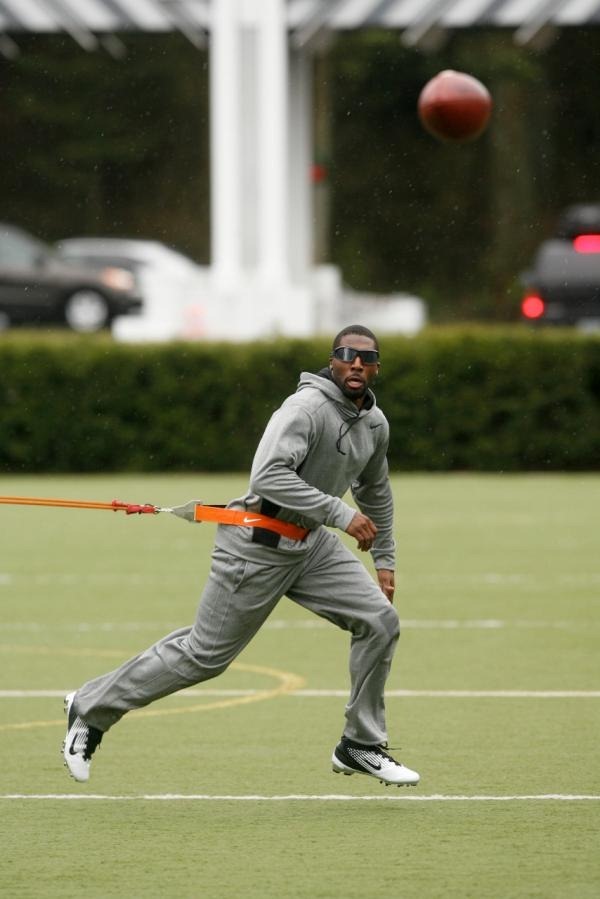Greg Jennings of the Green Bay Packers wears the Nike Vapor Strobe glasses while catching passes
Green Bay Packers wide receiver Greg Jennings knew exactly what his fellow receivers needed for Christmas: technology to help them catch the football – not that they need all that much help out in Green Bay.
As chronicled in my latest Sports Illustrated article (Jan. 9 print issue), the Nike SPARQ sensory performance training has NFL players turning to technology to improve their vision in an effort to up game performance.
(MORE: NFL Teams Turn to iPad Playbooks)
The first step in the process sends athletes through 10 sport-relevant visual and sensory tests on a giant touch-screen kiosk, gauging an athletes’ ability in everything from hand-eye coordination to decision making to reaction time. After undergoing the hippest eye test around, each athlete gets an instant report of their performance, all in relation to data from their peers. Jennings says he was pleased to find he scored strong across the categories, but plenty of others have used the data to pinpoint definite strengths and certain weaknesses.

Patrick Chung of the New England Patriots uses the kiosk (PHOTO: NIKE)
Using that information, athletes and trainers can then correlate the data into a training program, boosted by the use of the Nike Vapor Strobe eyewear that features liquid-crystal display lenses that cloud a player’s vision in 100-millisecond patterns, forcing athletes to more intensely focus on the main task at hand: spying the quarterback, finding the hole, spotting the open receiver or, in Jennings’ case, simply catching the ball.
“Your eyes are open to a level you are not going to have them open to,” Jennings says. “You are in tune to everything around you.”
While in Oregon recently, I had a chance to try out both the sensory training station and the strobe glasses. The 10-step sensory evaluation puts you through a mentally tasking technological test. Knowing my scores would get put up against those of elite-level athletes, the tension mounted and turned the sensory training station into a more realistic, pressure-packed situation. Let’s just say, I’m no elite-level athlete.
But Jennings is. “Even though you are working on enhancing an area and trying to improve, it turns it into a competition and a game that you get hooked on,” he says. “It draws you in. It is not like a test.”

Greg Jennings of the Green Bay Packers wears the Nike Vapor Strobe glasses while catching passes (PHOTO: NIKE)
Dr. Allen Reichow, Nike’s global research director for sensory performance and vision, has led the vision-improvement charge. “The eyes lead the body. Everything we do here is about seeing sport better,” he says. “We take vision away to let athletes see the game in a different way.”
Out on the field in Oregon, with Pittsburgh Steelers quarterback Dennis Dixon tossing balls, the strobes, even on the lowest of the eight settings that can completely impair your vision, made routine focus anything but customary for me. You were required to tune out the world around you and concentrate on the fundamentals. And I was only dealing with a few famous Oregon raindrops, not NFL safeties and linebackers.
One NFL safety who uses the strobes to focus, the Steelers Troy Polamalu, spends his time tracking down ball carriers even more than the actual football. “It has everything to do with reading your keys faster and putting your eyes in a certain place and a certain focus and then reacting according to what your keys tell you,” he says. “You gotta play the game with your eyes.”
Polamalu also likes the continual training capabilities of the SPARQ technology, giving him an opportunity to improve balance, depth perception and reaction time. “I always believed everything starts from the feet, but obviously everything really starts from the eyes,” he says. “Being able to wear the strobes and do these balance exercises added a whole different dimension of difficulty.”
Dixon says the strobes train him to keep his head properly positioned and also help teach him how quickly holes close.

Nike's Vapor Strobe glasses (IMAGE: NIKE)
A Duke University study confirms the technology offers improved vision, but Jennings says he didn’t need a study to know his focus has increased on the field, especially in difficult lighting situations. “You wear those strobes and it gives you that contrast and you see the ball a little better,” he says.
To get that extra focus in games, practice offers a new wrinkle. Jennings says one of his favorite drills is to get “like a bull in a ring and stand in the middle” and have people around him yelling “ball” and firing a football or tennis ball to him. With the strobes pumped high, he must tune in, focusing on the ball. And only the ball.

